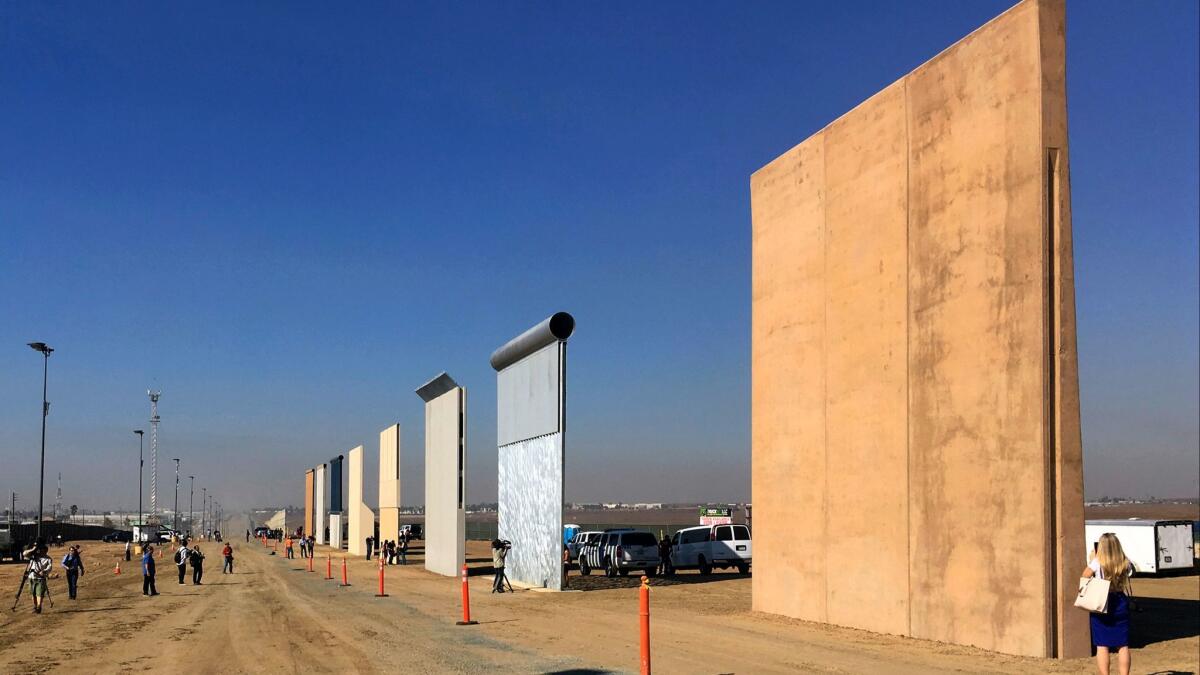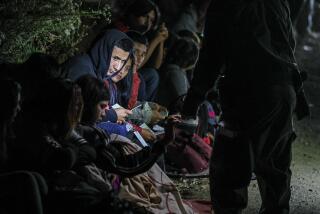Pizza and pellet grenades: How San Diego spent $50,000 prepping for border wall protests that never came

From Costco pizza and brown bag lunches to dozens of grenades that spew rubber balls in a 50-foot radius, San Diego police rushed to purchase $50,000 worth of supplies for security in the areas near President Trump’s border wall prototype project, much of it motivated by concerns for mass demonstrations that never materialized, city records show.
The purchases were ordered and made in the weeks before and just after the Sept. 26 start of construction on eight prototype walls on a patch of federal land near the border on Otay Mesa. The Union-Tribune reported in January that the city spent $826,354 on security, including about $227,500 in overtime and the balance in wages and supplies. The department was not providing security for the walls but patrolling and securing the area near the build — city streets in an Otay Mesa business park.
The U-T then requested a breakdown of the $50,000 in supplies as well as other information. Those records show the extent to which city officials believed they had to prepare for possibly large demonstrations against the project.
Department of Homeland Security officials had warned of large-scale and potentially violent protests in a memo to local agencies before the project began.
That memo, which has not been made public but was reported by the Wall Street Journal, clearly drove decisions by the police and San Diego County Sheriff’s Department, which also secured and patrolled the area and spent $1.6 million in salaries, overtime and supplies.
For example, on Sept. 12, the Police Department requested $25,000 to purchase meals for the expected monthlong project duration — an initial amount that officials said could go much higher.
“We may need to increase this depending on how the protests go as costs could rise to $100,000 or higher,” a management analyst wrote that day.
After a week it became apparent that there would be no protests and the city reduced manpower. In the end, it spent $5,778 on food, including 350 sack lunches and about two dozen pizzas one day.
The largest expenditure category was ammunition — and the records show the city bought an array of less-than-lethal tactical gear and ammunition. It included 750 rounds of pepper spray projectiles that can be fired from special launchers.
The city also bought 100 chemical grenades that spray out CS gas, commonly known as tear gas, as well as 50 grenades that spew out rubber pellets when detonated to deter and disperse large crowds.
Police said that the equipment is used by SWAT teams and the city does not have enough on hand.
“Our current inventory of munitions will not meet the demands of a long sustained and violent protest,” Capt. Rudy Tai of the Operational Support Division wrote in a Sept. 6 memo requesting the equipment.
The city ended up spending $33,969 on ammunition and tactical gear, the records show.
Concern over the protest also drove the Sheriff’s Department, which spent $764,278 for more than 10,000 hours of overtime logged by 356 employees from Sept. 7 through Dec. 15 in border wall-related costs and installed two miles of temporary chain link fencing to block off private and some county property.
The county got an exemption from environmental laws for installing the temporary fencing, while also saying the fencing would stop trampling on environmentally sensitive land “given the high likelihood a significant number of people will be demonstrating,” county officials wrote in a formal notice.
Despite all the concern, there were no protests during the building, and only a small rally near the site on Dec. 9, weeks after the walls were constructed and long after construction crews had left.
Both city and county officials have said that they will not be reimbursed by the federal government for the costs of securing the area for the prototype project.
To read this article in Spanish, click here
Moran writes for the San Diego Union-Tribune
More to Read
Sign up for Essential California
The most important California stories and recommendations in your inbox every morning.
You may occasionally receive promotional content from the Los Angeles Times.











